Turtles are a diverse group of animals that have been around for a very long time. The earliest known ancestor of modern turtles existed around 260 million years ago. Although most of the 300 known species exist in the sea, quite a few turtle species also live on land. Currently many are even kept for pets. While your average person will not have a tortoise running around in their backyard, smaller turtles have been popular at pet stores for years. This article aims to uncover the best tiny turtle pets as we go through the top 12 choices of small turtles for your home.
1. Musk Turtle: 2-5 inches

©Ontley, CC BY-SA 3.0 – License
Basics:
Musk turtles (Sternotherus odoratus) live in aquatic habitats throughout the eastern United States. Additionally, they prefer shallow bodies of water with low currents and much aquatic vegetation. They are primarily nocturnal turtles and rarely emerge from the water to bask. The musk turtle is dark brown and black with two recognizable stripes on its head.
Pet Care:
Adult turtle size: 2-5 inches
Lifespan: Up to 50 years
The musk turtle is a relatively common choice for a pet because they are small and easy to maintain. Despite being an aquatic animal, they are not particularly strong swimmers, so they tend to stick to the shallow waters. They can be spunky and scratch or bite if they feel uncomfortable. Due to that spunk, it is best to pick them up from the rear of the shell when handling them. If they feel threatened, they can release a foul odor.
What they need:
- 30-gallon tank for one turtle
- Basking platform
- Although they do not do this often, one is still necessary in their tank.
- Water filter
- Heater
- UVB lighting
2. Eastern Mud Turtle: 3-4 inches
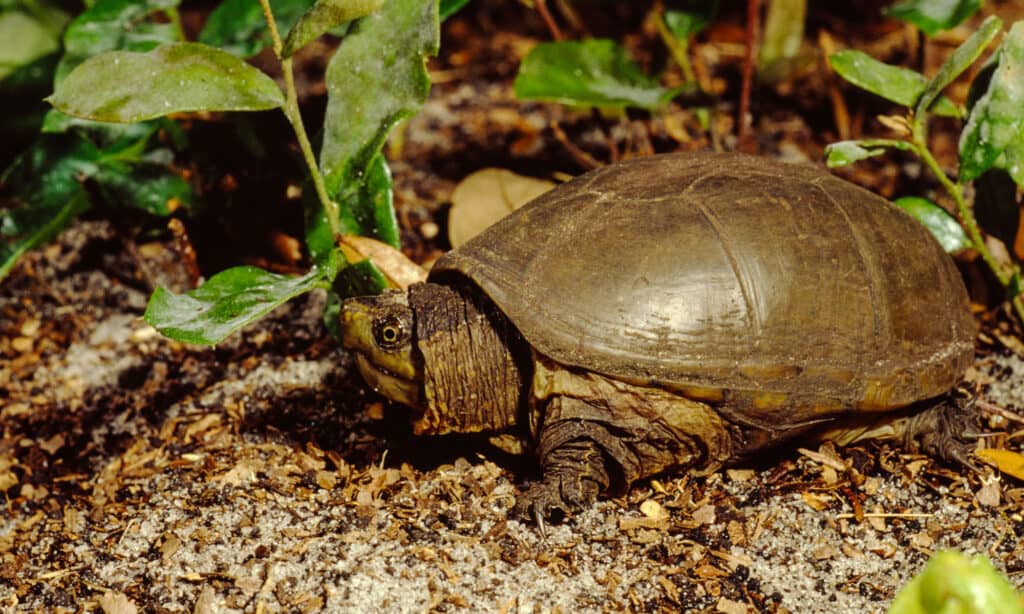
©Liz Weber/Shutterstock.com
Basics:
Listed as endangered, these semi-aquatic turtles can be found in fresh and brackish water, including marshes, ponds, wet ditches, fields, and offshore islands. Their upper shell is olive to dark brown, and their lower is yellow to brown. Also, eastern mud turtles (Kinosternon subrubrum) have horizontal yellow stripes along their face and neck. This turtle is found across the United States and prefers to live in shallow, soft-bottomed, slow-moving water.
Pet Care:
Adult size: 3-4 inches
Lifespan: 20-50 years
These turtles love swimming and spend more time in the water than they do on land. Therefore, their habitat should be primarily aquatic with a smaller terrestrial section. In addition, the habitat should also feature a bare tank bottom with large river stones. The water in the tank should be deep, twice as deep as the turtle’s length at the deepest part of the tank.
What they need:
- Large enclosure
- 20-gallon tank for young turtles
- 50-100 gallon tank for adult turtles
- Filter
- It would be best if you kept the rocks and water clean.
- Thermometer and heater
- Basking light
- UVB bulb
- Proper diet
- These turtles are highly carnivorous and enjoy freshwater fish, earthworms, and snails.
3. Spotted Turtle: 3.4-4.5 inches
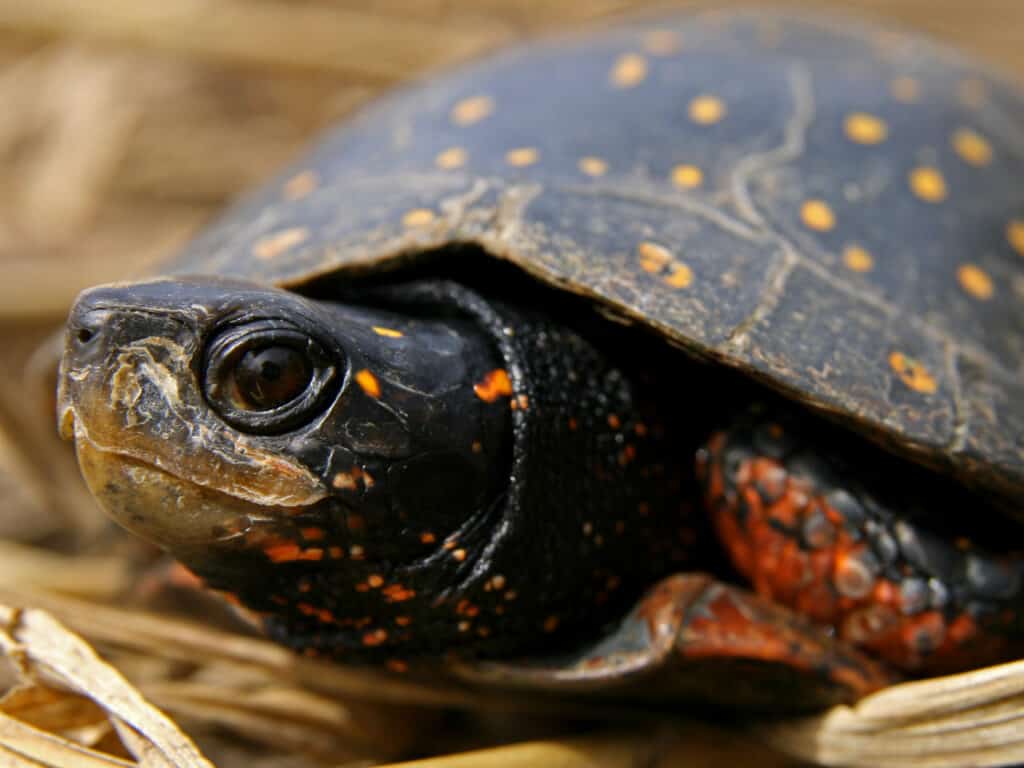
©Ryan M. Bolton/Shutterstock.com
Basics:
Spotted turtles (Clemmys guttata) are tiny aquatic turtles. Named for the yellow spots on their shells, they can be found in wetlands across the East Coast and the Great Lakes regions of the United States. These turtles enjoy shallow areas with tons of vegetation, but unfortunately, this species is threatened due to the loss of their habitat.
Pet Care:
Adult turtle size: 3.4-4.5 inches
Lifespan: Over 50 years
Spotted turtles are a popular choice of pet because they are attractive and do well both indoors and outdoors. Generally — with proper care — they thrive better in outdoor environments. Although popular, they are not the easiest turtle species to care for. They are a curious, alert, and active species but can quickly become stressed when overhandled. In other words, this species is much better for observation than handling.
What they need:
- An enclosure with shallow water. Do NOT have them in an enclosure with deep water as they are not strong swimmers.
- Logs and raised areas to rest
- Water filtration system
- Dechlorinated water
- Heater
- UVB lighting
4. Bog Turtle: 4.5 inches
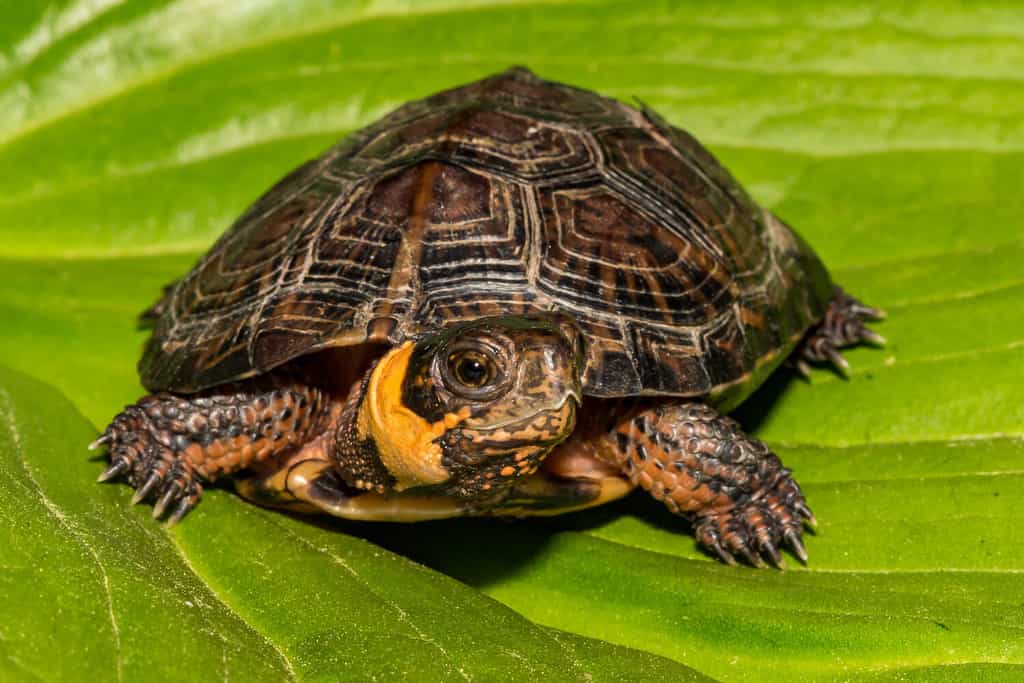
©Jay Ondreicka/Shutterstock.com
Basics:
The bog turtle ( Glyptemys muhlenbergii ) is one of the smallest in the United States. Their shells are dark brown and have no hinge, and the bright orange patch on either side of their face makes them easily recognizable. You can tell the males apart from the females because they have thicker and longer tails. These turtles live in bogs and wetlands with acidic soil and thick mud; they use the mud as protection from predators and weather. Unfortunately, the bog turtle population is dwindling so much that it is scarce to find them in the wild now.
Pet Care:
Adult turtle size: 4.5 inches
Lifespan: 60 years
Bog turtles are easy to take care of but have a semi-aggressive temperament and can be very territorial in their space. They enjoy cool, wet, and acidic habitats that resemble their natural habitat of a bog. Additionally, they enjoy having many places to hide, such as among mud or plants. Be careful when purchasing this type of turtle as a pet; this species is incredibly endangered, and it is illegal to find and sell one in the wild — but people still do. As a result, you should ensure the place you are purchasing the turtle from is reputable.
What they need:
- 2×3 foot enclosure — unless you are housing more than one turtle, then you need more space.
- A place with shallow water.
- A terrestrial area with lots of hiding spaces.
- UVB light bulb
- Heater
- Filter
- Adult turtles are fed three to four times a week — their diet includes worms, beetles, snails, aquatic plants, and berries.
5. Box Turtle: 4-6 inches

©Mark_Kostich/Shutterstock.com
Basics:
Box turtles (Terrapene carolina) are considered vulnerable. These turtles are found in the eastern and southern United States and Mexico. Their habitat includes forests, fields, marshy areas, and meadows, but this turtle is often found in residential areas. Consequently, being found in residential areas puts them at increased risk of being hit by cars, and many die while crossing the street. With dark brown or black shells and yellow spots, these turtles are usually easy to recognize. Box turtles have a range of territory equal to a football field and an S-shaped neck, allowing them to pull their heads into their shells. You can usually tell a male and female apart by the color of their eyes; males have red eyes, and females have brown eyes.
Pet Care:
Adult turtle size: 4-6 inches
Lifespan: 30-40 years
These are considered high-maintenance turtles to keep as pets, and there is debate on whether you should have them. Some argue that it is best to leave this species in the wild, while others say that they are one of the best and most common turtle types to have as a pet. Box turtles are solitary animals and shy — they like to stay out of sight of humans and other animals. For this reason, you want to ensure that your turtle’s habitat provides a lot of hiding places. You can house these turtles indoors and outdoors but indoors is considered safer. One concern with this turtle type is the risk of salmonella; according to the VCA, “ most turtles carry the infection asymptomatically.”
What they need: (Indoor Habitat)
- 20-gallon tank to start — 60-100-gallon tank upgrade
- Well ventilated enclosure
- Branches for chewing and rocks for climbing
- Non-toxic plants and hiding places (i.e., clay pots, hallowed-out logs)
- Shallow dish for food and shallow dish for water — with ramp
- Heat source and UV light
What they need: (Outdoor Habitat)
- Habitat needs to be escape-proof and predator-proof
- Offer shade and a place to hide from the rain.
- Rocks around the edge of the enclosure to prevent digging
- Bring indoors at temps of below 60 degrees Fahrenheit.
6. Diamondback Terrapin: 5.5-11 inches
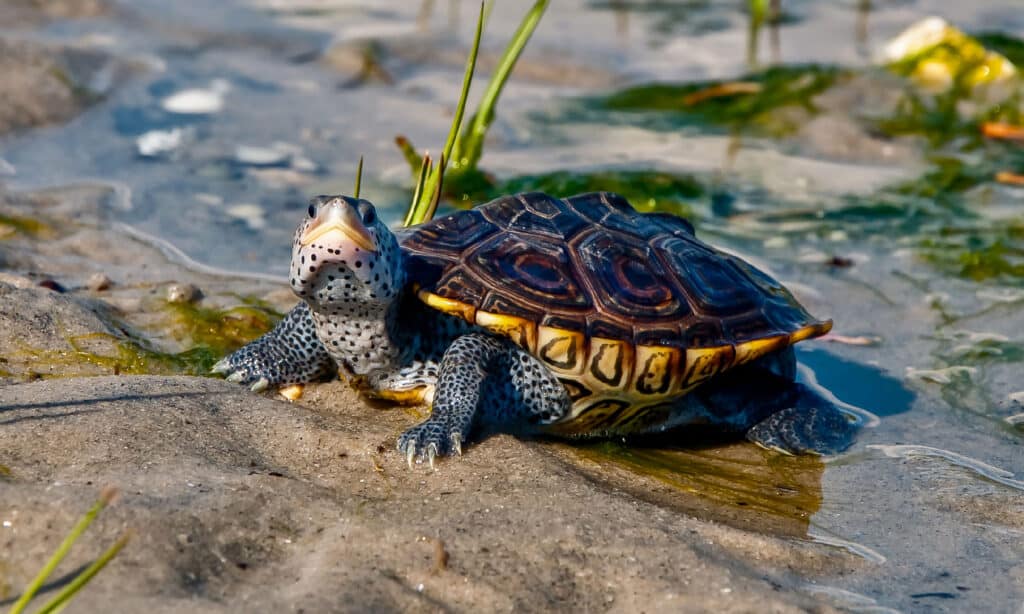
©iStock.com/JasonOndreicka
Basics:
Diamondback terrapin turtles (Malaclemys terrapin) are aquatic turtles with diamond-shaped markings. These turtles are medium gray-brown to black, and their skin has stripes. Diamondback terrapins are strong swimmers because of their webbed feet and muscular legs. They can be found in coastal salt marshes, estuaries, and tidal creeks along the United States. They can survive in these habitats because — similar to the sea turtles — they have glands that remove excess salt from their bodies. Known as Maryland’s state reptile, these turtles have a mainly carnivorous diet, feasting primarily on snails, crabs, clams, fish, worms, and insects.
Pet Care:
Adult male size: 5.5 inches
Adult female size: 8-11 inches
Lifespan: 25-40 years
Diamondback terrapins are great turtles to keep as a pet, but they require a lot of work. Although they can survive in nearly any type of water, it is recommended that you use salty water for their habitat. Their tank should have mostly open water with at least one dry land region for them to rest.
What they need:
- 80-100 gallon tank
- Filter
- Crushed coral
- Heater and UVB light
- Deep enough water to completely submerge
- A basking and resting section
7. Reeve’s Turtle: 6-9 inches

©Marek Velechovsky/Shutterstock.com
Basics:
Reeve’s turtle (Mauremys reevesii) is also commonly known as the Chinese pond turtle. It originates from east Asia and is considered a diurnal species — meaning they are active during the day and rest during the night. They are semi-aquatic turtles who enjoy basking in the sun and can be found in marshes, shallow ponds, streams, and canals with muddy bottoms.
Pet Care:
Adult turtle size: 6-9 inches
Lifespan: 10-15 years
This turtle is rated intermediate on the pet care scale. Reeve’s turtles require various foods, a glass aquarium, a robust water filtration system, and a large swimming area. Also, handling this turtle is not recommended. Additionally, due to their high protein diet, this turtle tends to be messier than others and requires more cleaning.
What they need:
- A habitat at least 23 inches in length
- A basking platform with a ramp
- Fully submerged sections of the habitat
- UVB light
- Clean and warm water
- Varied diet
- They are carnivores and tend to eat shrimp, meat, and insects
- Strong filter
8. Common Map Turtle: 6-10 inches
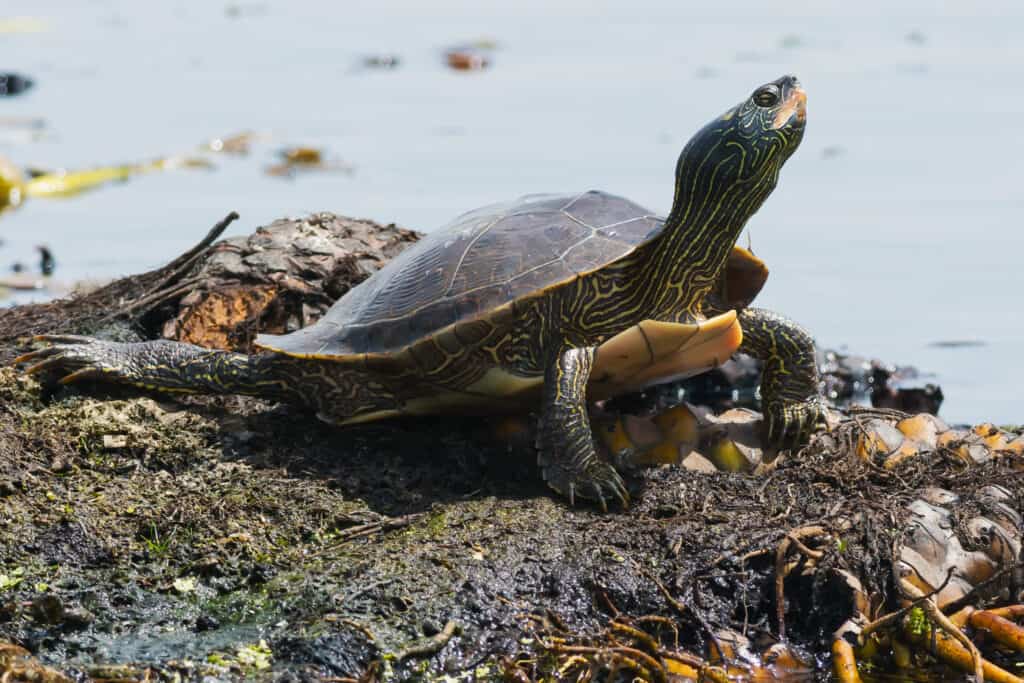
©iStock.com/PaulReevesPhotography
Basics:
The common map turtle (Graptemys geographical) is the most abundant and widespread turtle of its species. It features an olive green shell and faint yellow lines, with olive to dark brown skin and yellow and green markings. This species is far spread, ranging from Quebec to Alabama. They prefer large bodies of water such as rivers, large streams, and lakes and are more likely to be found in clear, flowing aquatic habitats with gravel.
Pet Care:
Adult male size: 6 inches
Adult female size: 10 inches
Lifespan: Up to 20 years
The common map turtle is excellent for experienced fish and other turtle pet keepers. They are entertaining turtles to watch as they are quite active and frequently swim around. This turtle can cohabit with other turtles, but males need to be kept separate. Despite their social prowess, map turtles can also be skittish and will retreat to deeper water if they feel threatened, so that needs to be provided.
What they need:
- 75-125 gallon tank
- UVB light
- Cover or hiding places
- Live or artificial plants
- A good-sized basking platform and deep water for swimming is needed.
- Dechlorinated water
- Be sure to leave a gap between the water’s surface and the tank lid; these turtles tend to be good at escaping.
- Water heater and thermometer
- Well balanced diet
- They are omnivores but primarily carnivores with a diet of crustaceans, insects, and mollusks with some vegetation.
9. African Sideneck Turtle: 7-12 inches
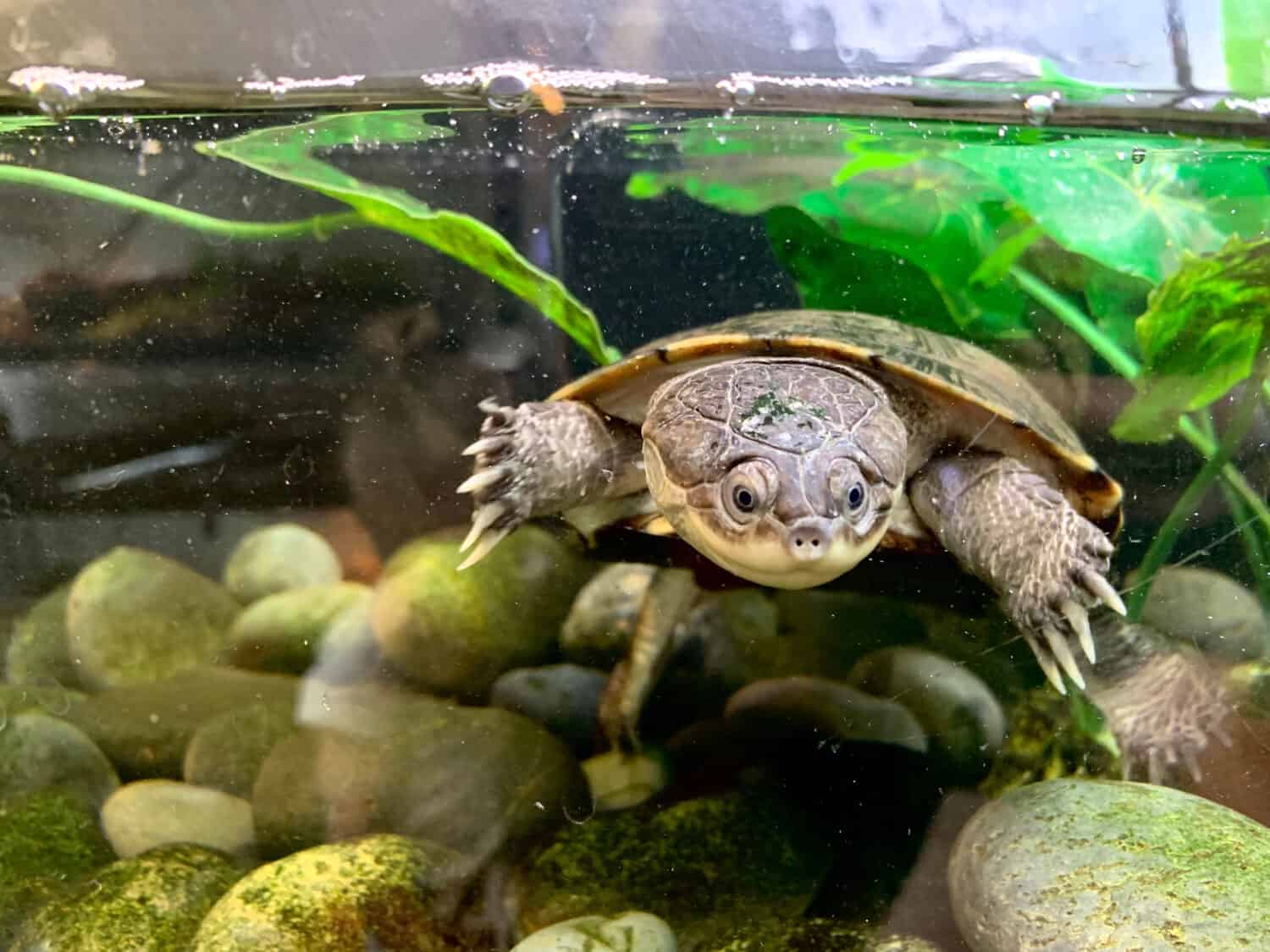
©Megan Czarnocki/Shutterstock.com
Basics:
African sideneck turtles belong to the family Pelomedusidae and are active and inquisitive turtles. These turtles have grey underbellies, flat dark green or brown shells, and a permanent smile. In the wild, these turtles live in ponds, lakes, and rivers with muddy bottoms that are found in the Western regions of Sub-Saharan Africa. These turtles are known for their long necks, allowing them to hunt for prey while remaining hidden. However, one drawback of their neck is that it prohibits these turtles from pulling their heads into their shells entirely. Despite that setback, their neck does come in handy somehow! For example, if flipped onto their backs, these turtles can use that solid neck for help. Due to the increased creation of manufactured ponds and lakes, this turtle population is on the rise.
Pet Care:
Adult male size: 7-10 inches
Adult female size: 8-12 inches
Lifespan: 25-50 years
Designed for beginner to intermediate pet keepers, these turtles are better for display pets than actively being handled. They are very entertaining to watch as they thoroughly enjoy exploring their tanks, but too much handling will cause this turtle stress. If they get stressed, the African sideneck is known to bite, and with their long neck, they could easily reach you. If you or your child want a turtle that can be easily held, there are better choices than this.
What they need:
- Aquatic habitat with a place to swim and a dry section to bask
- A ramp in and out of the water
- 75-gallon tank for individual turtle
- A heater
- A UVB light bulb
- A filter
- Places for turtles to hide, such as logs or plants
- Fed every 2-3 days — diet includes insects, mollusks, fish, veggies, and aquatic plants.
10. Painted Turtle: 8-12 inches

©KARI K/Shutterstock.com
Basics:
The painted turtle (Chrysemys picta) is North America’s most common aquatic turtle. This turtle lives in slow-moving waters such as ponds, streams, and marshes. Additionally, the painted turtles are freshwater turtles, and their ideal water source will have a muddy bottom where the turtle can hide and maintain its warmth. They have wide shells, dark skin, and colorful stripes on their legs and neck, although they may be difficult to spot as they spend most of their time under the water, only emerging to bask in the sun.
Pet Care:
Adult male size: 8 inches
Adult female size: 12 inches
Lifespan: Up to 50 years
Painted turtles are tame and engaging and are considered excellent pets for beginners and advanced pet owners because of their calm nature. These turtles love to swim and spend time under the water, so it is vital to provide a place for them to do so. These turtles also require a lot of sunlight and hiding places. Additionally, a varied diet is crucial to this particular species.
What they need:
- 36-48 inches long tank minimum
- 20 gallons of water per turtle
- UVB light and incandescent light for above the basking area
- Thermometers and heaters
- A place to hide away- both above and under the water
- Varied diet
- Adult turtles eat every 2-3 days
- Their diet includes insects, small fish and mammals, crustaceans, and nearby vegetation.
- Should be fed from a dish, apart from the live fish
11. Caspian Turtle: 9 inches
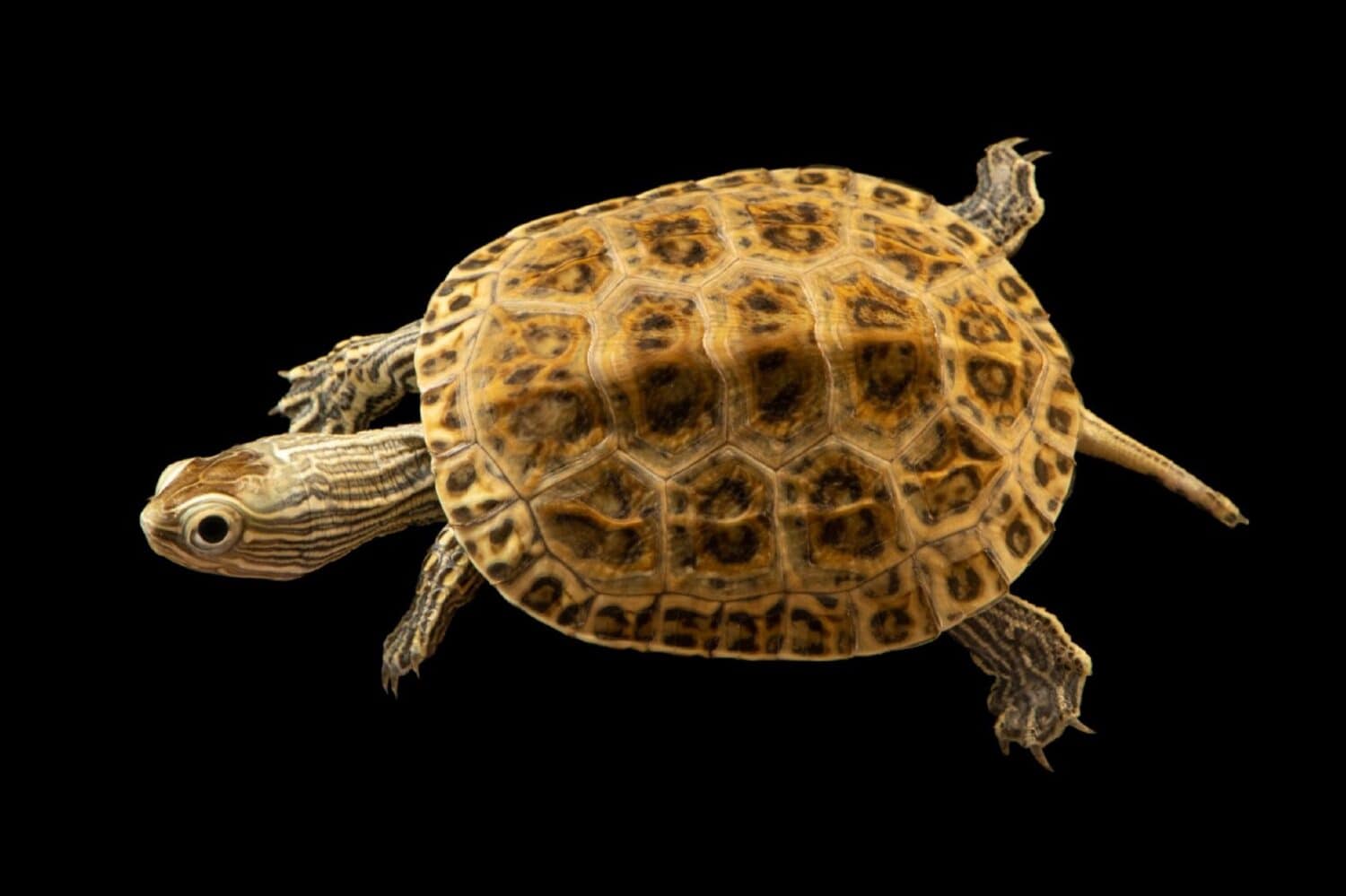
©Usha Roy/Shutterstock.com
Basics:
The Caspian turtle (Mauremys caspica ) is a highly aquatic black and brown turtle. Its shell is olive to black with yellow patterning, and its head usually has yellow striping. This turtle is native to eastern Mediterranean countries and often lives in permanent freshwater bodies. Nevertheless, it can be found in brackish water as well. These turtles are highly tolerant of water pollution. Because of their high tolerance, they can be found in water from fresh mountain streams to city drainage systems. However, even with their high tolerance, hundreds die due to pesticides.
Pet Care:
Adult size: 9 inches
Lifespan: 40 years
Caspian turtles are considered extremely friendly and easy to take care of with the proper care. Here are some of the Caspian turtles’ primary needs.
What they need:
- Fresh, non-chlorinated water
- 50-gallon water tank for a single turtle
- Airm pump and underwater filter
- UV sterilizer
- A section for basking — this species loves to bask
- Fed three times a week, the diet includes shrimp, small fish, larvae, mollusks, earthworms, crustaceans, and tadpoles.
12. Red-Eared Sliders: Up to 12 inches
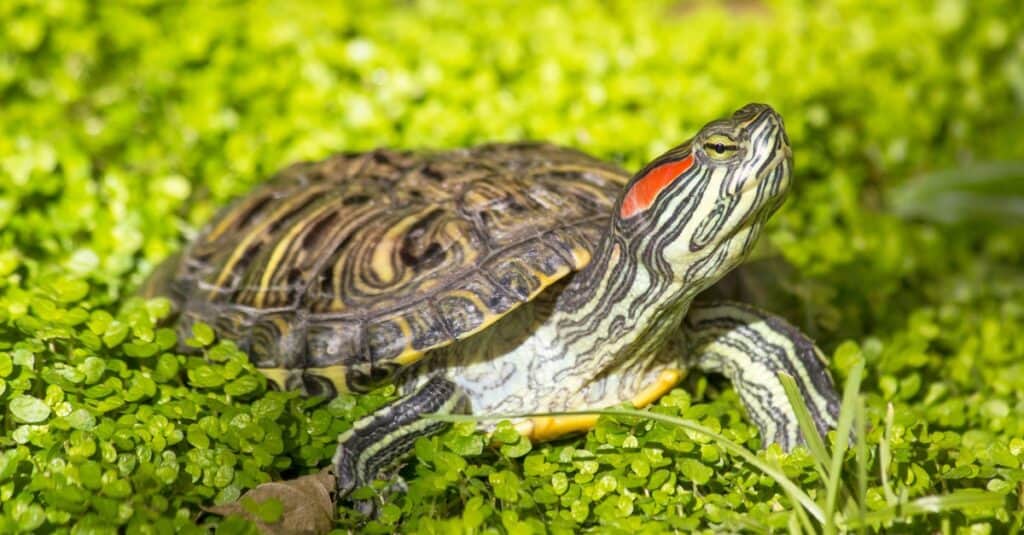
©xbrchx/Shutterstock.com
Basics:
The red-eared sliders (Trachemys scripta elegans) are semi-aquatic turtles that need to live near fresh or brackish water. They can be found in calm rivers, ponds, streams, creeks, swamps, and lagoons as they enjoy water that is slow-moving and no more than 3 feet deep. In addition, sliders are good at tolerating cold temperatures and spend much time basking in the sun. These turtles have webbed feet with claws and legs a head and tail adorned with green and yellow stripes. However, this turtle’s most distinguishing feature is a red stripe that runs behind its ears. The slider is a very sociable turtle that often congregates to bask in the sun. Still, they will slide into the water, earning their name when they are in danger.
Pet Care:
Adult turtle size: 12 inches or less
Lifespan: 30 years
The red-eared slider is a hardy turtle and is kept as a pet just about everywhere. They are not territorial or aggressive — one of the many reasons they make such a good pet — and are the most popular type of pet turtle on Earth.
What they need:
- Special lighting
- UVB
- Over 100 gallon tank
- Varied diet
- Their diet includes insects, insect larvae, spiders, crawfish, freshwater clams and sponges, eggs, snails, fish, slugs, small amphibians, and reptiles.
- Large water space
- Constantly clean and mimicking an outdoor, natural space
- Pre-formed pond liners can make their home resemble an outdoor pond.
- Constantly clean and mimicking an outdoor, natural space
- A basking platform
Summary of the Best Tiny Turtle Pets
| Rank (by Size) | Turtle Type | Size | Lifespan | Pet Features |
|---|---|---|---|---|
| 1 | Musk turtle | 2-5 inches | Up to 50 years | Easy to maintain but can be spunky and bite. |
| 2 | Eastern mud turtle | 3-4 inches | 20-50 years | Love swimming and spend much more time in the water than on land. |
| 3 | Spotted turtle | 3.4-4.5 inches | Over 50 years | Do well indoors and outdoors. |
| 4 | Bog turtle | 4.5 inches | 60 years | This species is incredibly endangered. |
| 5 | Box turtle | 4-6 inches | 30-40 years | One of the most common turtle types and is shy around humans. |
| 6 | Diamondback terrapin | 5.5-11 inches | 25-40 years | Recommended you use salty water in their habitat. |
| 7 | Reeve’s turtle | 6-9 inches | 10-15 years | High-protein diet makes them very messy turtles. |
| 8 | Map turtle | 6-10 inches | Up to 20 years | Excellent pet for experienced pet owners. |
| 9 | African sideneck turtle | 7-12 inches | 25-50 years | Better for displaying than for handling |
| 10 | Painted turtle | 8-12 inches | Up to 50 years | Calm turtles who love swimming. |
| 11 | Caspian turtle | 9 inches | 40 years | Extremely friendly and easier to take care of. |
| 12 | Red-eared slider | 12 inches or less | 30 years | The most popular type of pet turtle. |
The photo featured at the top of this post is © JasonYoder/Shutterstock.com
Thank you for reading! Have some feedback for us? Contact the AZ Animals editorial team.






